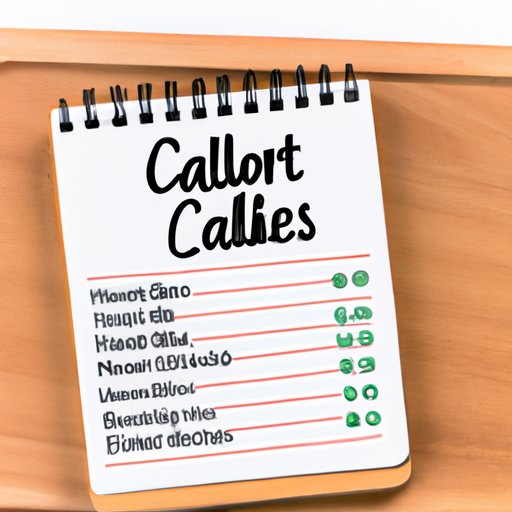

How to Achieve a Calorie Deficit: Practical Tips and Advice
Calorie deficit is a popular term used in the weight loss world. It simply means burning more calories than you consume. It’s a key factor that determines how much weight you can lose. Achieving a calorie deficit can be challenging, but it is possible with the right tips and advice. In this article, we’ll provide practical tips and advice on how to achieve a calorie deficit for effective weight loss.
The Basics of Calorie Deficit
To begin with, let’s define calorie deficit and explain its importance for weight loss. Calorie deficit is the state in which your body burns more calories than it consumes, leading to weight loss. It’s the basic principle behind every weight loss program. In order to achieve a calorie deficit, you need to know how many calories your body needs each day.
You can calculate your daily calorie needs using the following formula:
BMR (Basal Metabolic Rate) + Physical Activity Level = Daily Calorie Needs
BMR is the amount of energy your body uses at rest to perform its basic functions such as breathing, circulating blood, and regulating body temperature. Your physical activity level is the amount of energy you use during the day’s activities.
Once you know your daily calorie needs, you can decide how many calories to cut. A general rule of thumb is to cut 500-1000 calories per day to lose 1-2 pounds per week. It’s important to cut calories in a healthy way without compromising your daily nutritional needs. Portion control is key. Instead of drastically cutting your calorie intake, focus on eating smaller portions of healthy foods. Avoid high-calorie foods and beverages, and choose low-calorie alternatives. For example, drink water instead of soda, and eat fruits instead of candy.
Ten Tips for Successful Calorie Deficit
Here are ten actionable tips for achieving calorie deficit:
- Meal planning: Plan your meals ahead of time to avoid impulse eating.
- Mindful eating: Pay attention to what you eat, and enjoy your meals without distractions.
- Reducing sugar intake: Sugar is high in calories and can sabotage your weight loss efforts. Try to cut back on sweets, desserts, and sugary drinks.
- Increase physical activity: Exercise burns calories, increases metabolism, and helps create a calorie deficit. Aim for at least 30 minutes of physical activity per day.
- Eat more fruits and vegetables: These foods are low in calories but high in fiber and nutrients.
- Eat more protein: Protein helps you feel full and satisfied, reducing the chances of overeating.
- Drink water: Water has zero calories and helps you stay hydrated. It can also help you feel full and reduce your calorie intake.
- Track your progress: Keep track of your weight loss progress to stay motivated and on track.
- Get enough sleep: Lack of sleep can disrupt hormones that control appetite and metabolism, leading to weight gain. Aim for 7-9 hours of sleep per night.
- Seek support: Get support from friends or a professional to stay accountable and motivated.
Here’s how to implement each tip in your daily life:
- Plan your meals ahead of time using a meal planning app or template.
- Eat slowly, without distractions, and tune in to your hunger and fullness cues.
- Use natural sweeteners like honey or stevia instead of sugar.
- Take active breaks during the day, like going for a walk or doing some stretching exercises.
- Aim to have at least one portion of fruit or vegetables with each meal.
- Include lean protein sources like chicken, fish, or beans in your meals and snacks.
- Drink at least 8 cups of water per day, and avoid sugary drinks.
- Use a weight tracking app or journal to monitor your progress.
- Create a support network with friends or join a weight loss group.
Overcoming the Challenges of Calorie Deficit
Despite the benefits of calorie deficit, there are some challenges that people often face. Here are some common obstacles and how to overcome them:
- Hunger: Feeling hungry is a common side effect of cutting calories. To combat hunger, eat more protein, fiber, and healthy fats. These nutrients fill you up and keep you full for longer periods.
- Lack of motivation: Losing weight can be a long and tedious process. Keep yourself motivated by setting realistic goals, tracking your progress, rewarding yourself for good behavior, and by surrounding yourself with positive people.
- Binge eating: Overeating can sabotage your weight loss efforts. To avoid binge eating, don’t skip meals, and eat regular meals throughout the day.
Low-Calorie Meal Ideas
Here are some low-calorie meal ideas for breakfast, lunch, dinner, and snacks:
- Breakfast: Scrambled eggs with a piece of whole-grain toast, topped with avocado and salsa.
- Lunch: Grilled chicken salad with mixed greens, cherry tomatoes, cucumbers, and balsamic vinaigrette.
- Dinner: Grilled fish with roasted vegetables and quinoa.
- Snack: Carrot sticks with hummus dip.
Remember that variety and balance are important in meal planning. Don’t be afraid to experiment with different recipes and flavors.
The Science Behind Calorie Deficit
Behind the simple principle of calorie deficit lie complex mechanisms that govern our metabolism and energy balance. When you eat food, your body converts it into energy in the form of calories. These calories provide the fuel for all the processes in your body, from breathing to thinking to moving. If you consume more calories than you burn, your body stores the extra calories as fat, leading to weight gain. If you burn more calories than you consume, your body starts to burn stored fat for energy, leading to weight loss.
It’s important to balance your macronutrient intake – carbohydrates, proteins, and fats – in a healthy way. Carbohydrates provide energy for your body, protein helps build and repair tissues, and fat helps absorb vitamins and provide insulation. A balanced diet should include all three macronutrients in the right proportions.
Making Calorie Deficit a Sustainable Lifestyle Change
Finally, to achieve lasting weight loss, you need to make calorie deficit a sustainable lifestyle change instead of a temporary diet. You need to create healthy habits that you can maintain for life. Here are some tips for making calorie deficit a sustainable lifestyle change:
- Set long-term goals: Instead of focusing on short-term results, focus on long-term goals.
- Create a supportive environment: Surround yourself with positive people who support your weight loss journey.
- Don’t weigh yourself too often: Weight fluctuates throughout the day and week. Weigh yourself once a week or once a month to track your progress.
- Be patient: Losing weight takes time. Don’t get discouraged by setbacks or plateaus.
- Celebrate your successes: Rewards yourself for reaching your goals, but not with food. Choose non-food rewards like buying a new outfit or taking a day off work.
Conclusion
Achieving a calorie deficit is possible with the right tips and advice. In this article, we’ve provided practical tips and advice on how to achieve a calorie deficit for effective weight loss. Remember to cut calories in a healthy way, focus on portion control, and implement actionable tips such as meal planning, mindful eating, and increasing physical activity. Overcome obstacles such as hunger and lack of motivation by eating more protein and fiber, tracking progress, and seeking support. Make low-calorie meals and snacks a part of your daily diet, and balance your macronutrient intake. Finally, make calorie deficit a sustainable lifestyle change by creating healthy habits and setting long-term goals.





